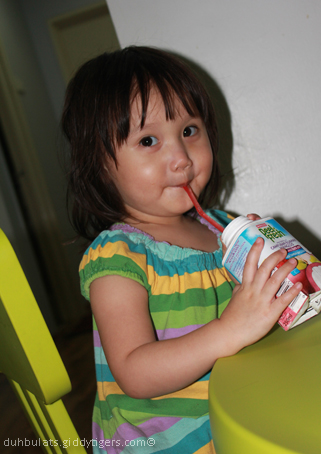
Today marks the completion of a 6-day antibiotic course for Hannah. She had been taking Cefaclor, a yellowish liquid form of antibiotics, which I suspect tastes a little lemony.
Prior to her antibiotic course, I was in great distress last week when Hannah suddenly developed extremely high fever. On Monday morning, she woke up with a low-grade fever of 37.5ºC, which shot up to 39.9ºC at lunch time. We brought the fever down with some PCM, but it went up again at dinnertime, and I decided to give her Bufren. At that time, her fever was 40.1ºC, and I was going out of my mind.
I tried to remain as calm as I could, and called the doctor, who said we could continue sponging and monitoring her condition first. The hospital’s pediatrician on duty was not Hannah’s usual doctor, and I preferred to wait till morning. It was a very worrying situation because at that time, Pete was away on a business trip overseas, but thankfully his parents were staying with us. Another worrying factor was that besides the immensely high fever, there were no other symptoms like sore throat, cough, earache…
Anyway, we got through the night and I brought her to the doctor early the next morning. Her fever was registered at 39+ºC at the clinic, and after she was given a dose of PCM, we were sent to the pediatric ward immediately for sponging.
Although we did some sponging of our own at home, I learnt the correct method of sponging a child, and here are some pointers to note:
- Strip child completely, but diapers and undies can be left on.
- Using lukewarm/tepid water (NOT cold, NOT warm), wet some towels and when slightly dripping place towels on child’s body. I used traditional nappies to sponge at home, because I find that they are lightweight enough, yet can hold sufficient water for the purpose.
- Leave the towels on the child for some time, and repeat where necessary.
- Wipe dry when sponging is completed.
- Temperature should drop about 10-15 minutes after sponging.
Because of her high fever (and no other symptoms), Hannah had to take a blood test to rule out dengue. We went home after that, but because her fever was still high, I gave her another dose of Bufren (Bufren is not to be administered if a patient is suffering from dengue). She didn’t mind the Bufren because it was orange-flavored.
Bufren brought her fever down somewhat, and when I called the doc for her blood test results, it was negative for dengue (thank God), so that only meant and indicated that Hannah was suffering from a bacterial (and NOT viral) fever and infection, which meant she needed a course of antibiotics.
Because she was in a lot of pain and suffering, I had to sometimes overlap her dosage of PCM and Bufren (yes, I had also just learnt that we can do that if necessary), and continued with sponging whenever she allowed me to.
After a dose of the Cefaclor antibiotics, her fever subsided to around 38+ºC and throughout that night, I made sure it did not go above 38.2ºC. In the morning, Hannah woke up with a smile and when I took her temperature, it was 36.9ºC ! 🙂
“I don’t have fever anymore, Mommy?” she asked.
No you don’t, baby…and I am so glad to have you back to your usual cheerful, cheeky and adorable self. Her appetite is improving now and I’m so very pleased.





2 comments
Comments feed for this article
Trackback link: http://duhbulats.giddytigers.com/2011/11/21/feverish-nightmare/trackback/